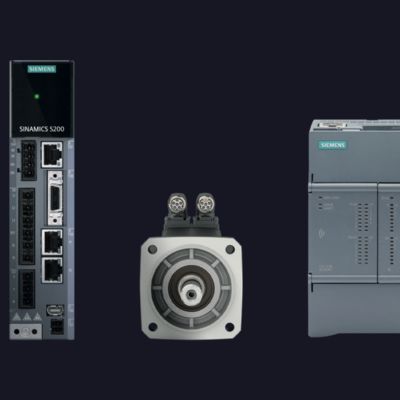Planning a full-line control package heads off such problems. Avoiding the unplanned downtime is, of course, one big advantage, but there are others.
“A controls package for the entire press line means that a stamper has one set of schematics for that entire line, and one source for controls,” Eby says. “Often, a press with its own control teamed with a feed and uncoiler with their own controls results in poor documentation on how everything wires together. This creates an assortment of problems and challenges.”
Eases Operator Training
One challenge: training. Operators must be well-versed on controls for all line components. And, such setups rarely are mimicked on other press lines on the plant floor, which hinders the ability for operators to rotate among the various lines. This requires additional training specific to each line’s control systems.
Also, instead of operating a press line from a single control panel, operators must hopscotch from one end to the other to ensure proper equipment setups and full-line operation. One more challenge: Line components must synch with each other to enable proper part production for each job. For shops experiencing multiple job runs daily on a line, setup can become quite a headache.
“Staffing a pressroom is a huge challenge as it is,” Eby says. “Stampers have trouble keeping the same employees long-term. Having to train them on different lines adds to the trouble. A press line residing under a single controls umbrella helps solve such problems. And, even better if a stamper can standardize that controls umbrella across multiple lines.”
Developing an all-encompassing controls solution increases productive uptime. In addition, the latest controls offer technology for maintaining such uptime. An example: remote connectivity through products such as Ewon, which allows secure online connections that enable remote support and maintenance.
“Using the Ewon gateways allows for remote troubleshooting, which provides comfort for stampers that have few people on staff capable of troubleshooting controls, and don’t have the time to conduct troubleshooting on their own,” Eby says.
Assess Controls Now
These ideas sound great, thinks the stamper, and now it’s time to consider an umbrella control for the press line, or multiple lines. What’s the next step?
“Stampers should take the time to go through each press line to determine risk,” Eby says. “Consider every line from a controls perspective, write down the major components and what happens if they fail. Ask how needed replacement parts can be obtained—if they’re available, how much they would cost, and how long before they arrive and can be swapped out.
“Once stampers determine the risks,” he continues, “they may want to accelerate the upgrade-planning process in order to avoid unplanned-downtime situations. Even procuring some needed equipment and having it sit somewhere at the plant helps, as at least it’s inhouse and ready for install should something go wrong.”
One more piece of advice from Eby on dealing with obsolete controls equipment: An upgrade on one line can free up spare parts for other lines with obsolete controls.
“A stamper can have one line upgraded and place older parts on shelves to service other lines,” Eby says. “This can save time in having to source such components.” MF
See also: Toledo Integrated Systems
Technologies: Pressroom Automation, Sensing/Electronics/IOT
Comments
Must be logged in to post a comment. Sign in or Create an Account
There are no comments posted.Press-Control Retrofit Streamlines Robot Integration
Todd Wenzel February 27, 2023
 Pressroom Automation
Pressroom AutomationNext-Generation Motion-Control System for Basic Automation A...
Friday, June 27, 2025
 Pressroom Automation
Pressroom AutomationYaskawa America Announces Expansion and Relocation of North ...
Thursday, June 19, 2025







 Using older controls on a press line, which often includes separate controls for the press, feed line and other equipment, a metal former must maintain spare control components on the shelf, or at least at the ready via used-equipment markets. As the pandemic took hold, inhouse spare parts flew off the shelves and into the lines, and spare parts via secondary sources such as eBay did the same. Procuring such parts became increasingly difficult and prices soared. With that, quick-fix approaches to press-line controls became prevalent.
Using older controls on a press line, which often includes separate controls for the press, feed line and other equipment, a metal former must maintain spare control components on the shelf, or at least at the ready via used-equipment markets. As the pandemic took hold, inhouse spare parts flew off the shelves and into the lines, and spare parts via secondary sources such as eBay did the same. Procuring such parts became increasingly difficult and prices soared. With that, quick-fix approaches to press-line controls became prevalent.  “We receive calls from stampers wanting control retrofits on presses because they just can’t find spare parts to keep older controls going,” he says. “We’ll visit and notice that the feed drive also is obsolete. Some drives no longer are available or serviceable. We’ll bring that to light and quote options for replacements. Stampers see that it pays to replace those obsolete units as well to avoid all the disastrous problems surrounding unplanned downtime.”
“We receive calls from stampers wanting control retrofits on presses because they just can’t find spare parts to keep older controls going,” he says. “We’ll visit and notice that the feed drive also is obsolete. Some drives no longer are available or serviceable. We’ll bring that to light and quote options for replacements. Stampers see that it pays to replace those obsolete units as well to avoid all the disastrous problems surrounding unplanned downtime.”